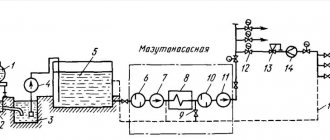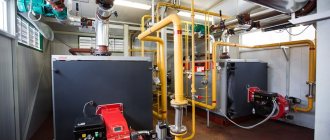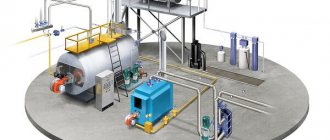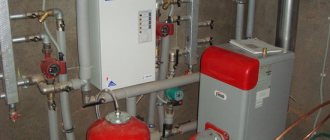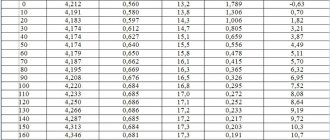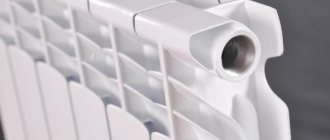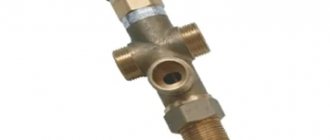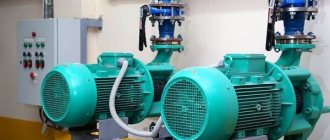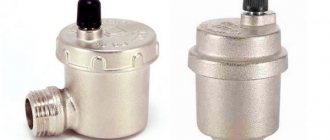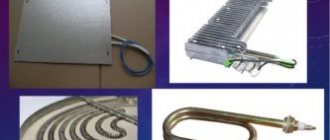Construction of a homemade stove during development
It’s quite simple to create the simplest heating during testing with your own hands. Heating furnace using waste oil. consists of two containers that are connected by a pipe located between them. The design element is also a chimney, which is designed to remove combustion products.
Containers are usually made of 4 mm metal, and 6 mm thick sheet metal is suitable for making the lid of the second container. The use of steel can significantly increase the service life of this structure, since sheet metal that is too thin will burn out very quickly.
The diameter of the connecting pipe container must exceed 10 cm, and its length must be at least 4 times the thickness. It is necessary to drill 48 holes with a diameter of 9 mm in the side of the pipe. As practice shows, these holes are very well arranged in six rows, i.e. Each row has eight holes.
The chimney pipe is made of fire-resistant steel and is located above the upper container. The upper part of the pipe can be made of any material (tin, ceramics), because the gas, reaching the top point of the chimney, cools significantly. The height of the chimney usually ranges from four to seven meters.
To improve heat transfer, it is worth using a chimney located at a slight angle, but the upper part should be located vertically so that the wind cannot prevent the smoke from escaping. To protect against precipitation, you can install an umbrella or visor on the pipe. When assembling a chimney pipe, it is necessary to take into account the fact that in the future it will need to be regularly cleaned of settling elements, so it is best to make the chimney dismountable.
A connecting pipe is welded to the lid, to which, in turn, the upper container will be attached. The chimney is connected precisely to the upper tank in the place that was provided for this. The hole in the lid must be equipped with a damper, which, when the device is operating, will affect the combustion intensity. In addition, this damper allows you to reduce the amount of soot that comes out of the chimney. The hole drilled in the lower container will be used to pour oil, ignite the stove and regulate draft.
The design is very simple, and such heating can be built with your own hands without much effort. The compact size and convenient shape make it possible to make such a stove “on-site”, which makes it possible to use it, for example, for heating a greenhouse in a country house. Hot air comes out through holes drilled in the connecting pipe, and its temperature can reach 90-95 degrees Celsius. In addition, such a stove heats up quite quickly.
Reviews of household liquid fuel boilers: advantages and disadvantages
| Advantages | Flaws |
| Reliability - liquid fuel boilers, especially if they are expensive European models, are durable and trouble-free | The use is not always justified in economic terms. Diesel models have high fuel costs, and used oil models themselves are extremely expensive. To obtain benefits, you need to comply with many conventions. |
| Operating costs – almost any type of fuel can be obtained at a fairly low cost, especially used oil | Energy dependence - due to forced-air burners, all liquid fuel models require connection to the electrical network |
| Autonomy - after starting and setting up the boilers practically do not require human intervention throughout the entire season | The operation of burners and boilers in general is quite noisy, but the owners note that the noise is not audible even behind the thin walls of the boiler room |
| Availability of both single-circuit and double-circuit models | The need for good ventilation, according to reviews from the owners - forced, natural - does not relieve the room from the constant smell of fuel |
| Almost all models are equipped with a standard list of protection systems | |
| No permission required for connection and installation |
Operating rules
In order for the heating to last a long time during testing and not cause an accident, it is necessary to follow the basic operating rules:
- Under no circumstances should used oil be replaced with gasoline, acetone or other flammable substances.
- There should be no flammable substances near a functioning stove. Fuel cans located near the stove may explode if overheated.
- If water enters the system, a flame may erupt, so you must carefully ensure that the stove is dry.
- In the event of a fire, under no circumstances should the stove be extinguished with water. To extinguish a fire, you can only use a fire extinguisher, which must be located in the room where the stove is installed.
- The ventilation must be open while the stove is operating. If you block the access of clean air to the room, then after some time the concentration of carbon monoxide will become life-threatening.
Tools and materials
To make your own boiler, you will need:
- sheet steel with a thickness of 4 mm;
- metal pipe for air duct;
- 4 pieces of reinforcement with a cross section of 8 or 10 mm;
- compressor;
- pump;
- welding equipment;
- expansion tank;
- Bulgarian;
- asbestos sheet;
- half-inch corners, bends and tees for the burner;
- steel adapters;
- heat-resistant sealant.
The boiler can have any shape, therefore. If there is no sheet material of the required thickness, you can take a thick-walled pipe of large diameter or a cylinder of a suitable size. The simplest furnace for mining is made from a pipe with a diameter of 50 cm, a pipe with a diameter of 20 cm, and two round steel plates with a thickness of 3 mm. Despite the simplicity of the design, this stove does an excellent job of heating a standard-sized garage.
Manufacturing of waste oil boilers
Boilers are more complex devices that can operate on waste oil. You can assemble them according to the drawings with your own hands. but for safety reasons it is better to buy factory products. According to the principle of operation, this heating equipment is similar to boilers running on diesel fuel.
When designing a heating boiler, take into account the size of the room that is planned to be heated using this equipment. The height of the ceilings also matters. If it is planned to organize, in addition to heating, a hot water supply, then double-circuit hot water boilers are installed, which also operate on waste, reused oil. It is possible to use single-circuit boilers combined with a boiler for these purposes.
Diagram of a hot water boiler operating on waste, recycled motor oil or fuel oil. The dimensions of all parts are indicated in centimeters
As you can see, you can organize heating using waste oil with your own hands using both homemade devices and factory models. The use of the latter guarantees the safety of their operation, since all technological requirements are met during assembly.
The author so boldly suggests making a liquid fuel boiler yourself that I wanted to object. Firstly, ready-made heating boilers are sold, designed to burn waste oil. These boilers can be installed at the same service stations and have free heating and hot water. They are safe and reliable in operation. Liquid fuel boilers are much more dangerous to operate than gas or solid fuel boilers. If oil spilled near the boiler catches fire, you can get such a headache that it won’t seem like much. Especially if several neighboring garages burn down along with their cars.
I made a stove for testing according to the above scheme - the stove ignites and shoots hot oil, it’s good that there were no consequences because put it in the garage. The ceiling above the stove is black, damn, I wasted so much time in vain. Yes, I added more work to myself.
Site navigator
Design and principle of operation
Liquid fuel boilers are both single-circuit and double-circuit, but exclusively energy-dependent models, the operation of which requires a connection to the electrical network. In fact, liquid fuel models differ from gas models only in the burner, which is adapted to the characteristics of a particular type of fuel and is equipped with a turbocharger necessary to spray the fuel throughout the combustion chamber. Any type of liquid fuel requires preheating, which is also carried out in the burner, all this makes it so massive and large-sized.
The rest of the operating principle is standard:
- Fuel from the reservoir is supplied to the burner heating chamber, then atomized using a nozzle and ignited in the combustion chamber.
- Above the combustion chamber there is a heat exchanger, which heats up and transfers thermal energy to the coolant located inside (often all the walls of the combustion chamber are a heat exchanger).
- The coolant (usually water) circulates through the system giving off heat to the heating radiators.
There are also models with a different structure and operating principle; we have already described them in a more detailed analysis of diesel boilers and boiler units that burn waste oil:
All the details you need to know about diesel boilers for heating a private home
All the details you need to know about waste oil boilers for a private home
Gas boiler burners.
Gas burners come in two types: ejector and blower (fan). Blast gas burners, similar to diesel ones, are used on boilers with closed combustion chambers. Such burners can be equipped with fuel equipment and also operate, depending on the conditions, on liquid fuel. In addition to the step mode, some burner models operate in modulation mode, i.e. their power varies smoothly within a given range. Ejector burners, unlike blast burners, are built into the boiler firebox and are an integral part of it. The parameters of such burners depend on the design of the boiler heat exchanger and cannot be changed during operation. Ejector burners are quite simple and at the same time reliable in operation. The principle of operation is as follows: - when a high-pressure flammable gas passes at high speed and pressure through a nozzle (tapering cross-section), a vacuum area is created in the mixing chamber, where primary atmospheric air rushes. The two streams are combined to form a mixed stream. Having passed the mixing chamber, the flow rushes into the diffuser, in which it slows down and pressure increases. At the exit from the ejector, the mixed flow is combined with secondary air entering the boiler furnace, where combustion occurs. The simplest burner device consists of a fuel atomizing nozzle, a mixing chamber, an igniter, a fuel valve that interrupts the fuel supply, and a flame control sensor. A heating boiler can have from three to fifteen such burners. Contamination of the burner mixing chamber leads to a lack of primary air, which leads to combustion with a lack of oxygen, i.e. the burner begins to smoke and pollutes the combustion chamber with soot. Repairing a boiler with such a malfunction is quite complicated and includes disassembling the boiler, cleaning the firebox and burner. To prevent the development of such a situation, boiler maintenance should be carried out at least once a year. Ejector burners can also be stepped or modulated, however, a decrease in power, due to the design features, can negatively affect the stability of the torch combustion. Also, the burner operating mode is affected by the amount of vacuum in the boiler furnace, which in turn depends on the parameters of the chimney. The main type of fuel for such burners is natural gas. When using liquefied gas, it is necessary, unless there are restrictions from the manufacturer, to reconfigure the device to another type of fuel. In ejector burners, to convert to liquefied gas and vice versa, it is necessary to replace the nozzles on the fuel rail. The design of forced-air gas burners is similar to diesel burners. Since the gas enters the burner under pressure, there is no need for a fuel pump. The air part of both burners is almost identical. The fuel supply is regulated by a gas solenoid valve, controlled by command from the combustion machine. To change the burner power, adjust the gas pressure at the burner nozzle and the position of the air damper. Additionally, the burner is equipped with an air and fuel pressure sensor.
What needs to be assessed when choosing a boiler that runs on liquid fuel
If circumstances are such that a diesel boiler becomes the only reasonable alternative, then it is necessary to be able to correctly select the optimal model.
- Boilers vary in type of design. Most of them are designed for permanent installation on the floor. However, you can also find compact imported wall-mounted models. That is, when choosing, you must be guided by the available possibilities for placing the device - where and what space can be allocated to it.
However, wall-mounted liquid fuel boilers are rare, they are not particularly popular, and basically everyone opts for floor-standing models. And if so, then an important point is the dimensions of the boiler and its weight - for some models it may be necessary to strengthen the floor surface before installation, or widen the doorway to bring the equipment into the boiler room.
- The thermal power of the boiler must meet the needs of the heating system being created. This parameter, by the way, is very closely related to liquid fuel consumption; we will consider it below and in more detail.
- It doesn’t matter whether the burner is built-in or removable, you should pay attention to the number of modes of its operation (in terms of power). So, they can be single-stage, two-stage, three-stage, and even working on the principle of flame modulation depending on changes in environmental conditions. The more stages, the more accurately the operation of the boiler can be adjusted, the fewer start and stop cycles there will be, the lower the fuel consumption. True, the cost of the equipment increases in proportion to the number of stages.
Three-stage diesel burner model “Uret U12VTTU”
- Of course, when purchasing a boiler or burner, you need to know in advance what type of liquid fuel will be used. The vast majority of consumers prefer diesel fuel, which means that diesel fuel should be indicated in the product data sheet.
Waste oil burners can be cost-effective at automotive enterprises, where this “good” is available in abundance and is practically free. Fuel oil is also not in demand among private owners, despite its price not being as high as that of diesel fuel. Biofuel, presumably, has a great future, but in our area it is still perceived at the level of “exotic.”
What is biofuel and how do you get it yourself?
Many industrial agricultural crops, food production and wood processing wastes contain oils and other organic compounds, which, after appropriate processing, can be turned into a completely valuable fuel, similar to diesel. What is the processing process, and is it possible to obtain biofuel with your own hands ? Read the special article on our portal.
By the way, the cheaper the fuel, the lower its calorific value, and the higher the cost of a burner or boiler designed to work with its use.
And yet, there are also burners that can work with different types of fuel. Versatility is, of course, a good thing, but such devices are not particularly praised, including for being too overpriced, for low reliability and a clear decrease in efficiency. So make your own choice...
- The boiler can be single-circuit, that is, it works only to heat the coolant for the heating system, or double-circuit, which has an additional heat exchanger for hot water supply.
It must be said that liquid fuel boilers usually have considerable power, and it is better to connect an indirect heating boiler to them - this way the operation of the equipment will be more “smooth”, without frequent switching on and off of the burner. And the need for hot water will be fully provided, since the hot water supply will be organized according to the accumulating principle: the necessary supply is always at the service of the owners.
No one forbids purchasing a double-circuit diesel boiler, but these are extra costs and additional “vulnerabilities” in the equipment itself, which reduce its durability.
The optimal combination is a diesel boiler with a replaceable burner, that is, with the ability to switch to a different type of fuel, and an associated indirect heating boiler
- The boiler (or diesel burner) safety and control system is one of the key criteria for choosing equipment. Built-in thermostatic sensors allow you to set the required temperature regime of the heating system - upon reaching the required threshold, the boiler will be switched to minimum consumption. In more modern models, sensors react not only to preset coolant temperature parameters - they evaluate changes in external conditions, and the automation develops the most rational mode of operation of the boiler.
A special electronic controller is capable of regulating other parameters - the flow of air and fuel to create a fuel mixture, the required level of heating of diesel fuel, the presence of a flame and the stability of the torch, and others.
The most important task of automation is to ensure the safe operation of equipment. Thus, the control unit must respond to overheating of certain burner components, excess or insufficient pressure in the supply pipelines, the absence or insufficiency of draft, indicating the need to clean the heat exchanger and (or) chimney channels, self-extinguishing of the torch, which is a sign of clogged nozzles, lack of coolant in the water circuit. Many modern models are equipped, in addition, with a self-diagnosis system, and in the event of any violations or failures, a corresponding indication appears on the device display.
By the way, boilers that run on liquid fuel and have modern control modules fit perfectly into the “smart home” concept, and they can be controlled remotely via various communication channels, including IP and JSM.
- Since the question of purchasing a liquid fuel stake has arisen, then we should probably immediately think about the problem of storing reserves of this very fuel.
Currently, there are many options for spacious tanks made of metal or durable plastic that are resistant to petroleum products. The plastic version would probably look better.
The range of such containers is quite large, and they differ in both shape and volume. Of course, the most reasonable solution would be to purchase a tank into which you can fill the reserve for the entire heating season, but this depends on who has space and finances. In principle, there are also very small containers on sale, designed for daily consumption, but there is no need to talk about the convenience of this approach.
The diagram below shows one of the standard tank options:
Diesel fuel storage tank kit for heating needs
1 – housing made of durable plastic, manufactured using seamless rotomolding technology. The presence of stiffeners and the special configuration of the body ensure its strength and resistance to both external influences and liquid pressure from the inside.
2 – filler neck, tightly screwed after filling the container.
3 – a drain valve that allows you to drain the remaining sediment after the entire fuel supply has been used up before the next refueling.
4 – the necessary set of fittings – for installation of fuel lines and other tank piping components.
5 – fuel sensor, mechanical, float type – provides information about the presence and quantity of fuel in the tank.
6 – fuel intake with a hose (the length of the hose ensures fuel intake along the entire height of the container). The suction end of the hose is equipped with a float, which allows you to always remove fuel from its surface, that is, in its purest form.
7 - the so-called “breathing valve”, necessary for releasing excess fuel vapor into the atmosphere. It is usually installed in the trunk of the ventilation duct, and connected to the tank with a special inch pipeline.
8 – a set of pipes (copper or polymer) for organizing a fuel supply system from the tank to the burner. In some cases, when the design of the boiler or burner requires it, reverse flow is also organized. Unused, excess fuel is returned through it to the container.
9 - fuel filter. Installed optionally, only if fuel filtration is not provided for in the design of the burner itself.
Two people can install such a tank - there is nothing complicated in its tying. The service life of such a polymer storage facility is estimated at 50 years.
But what volume of tank is needed? As already mentioned, it is most advisable to stock up for the winter right away - it will be cheaper, and the likelihood of unpleasant moments when fuel is running out and there is no possibility of its delivery (under the same weather conditions) at the moment is excluded. As a last resort, you can create reserves for one or a couple of months of battery life. But purchasing containers with refills for a week or two is completely impractical.
We’ll talk about the boiler power and the required fuel reserves in the next section of the publication.
Types of regulation of oil burners
Burners installed for oil-fired boilers differ in the number of stages and the method of power adjustment. The main types of burners are:
- Single-stage - operation occurs at one power, which is pre-adjusted taking into account the permissible range.
- Two-stage - during operation it is possible to use both 100% and 50% power. The choice of operating mode and the transition to it is carried out by the automation system, while it is possible to configure modes with other indicators in the burner power range.
- Smooth two-stage - they have two operating modes at different powers, but the transition occurs smoothly.
- Three-stage - work is carried out in three operating modes.
- Modulating - the burner power is adjusted smoothly depending on the temperature or pressure in the boiler, heat generator or furnace.
